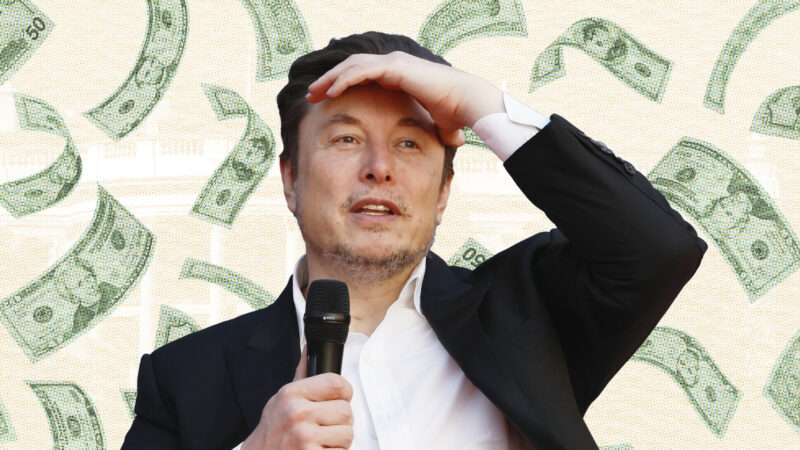How Donald Trump and Elon Musk Could Cut $2 Trillion in Government Spending

Elon Musk has thrown down a $2 trillion gauntlet, claiming he can slash federal spending by that amount. While the billionaire’s proclamations on X often generate more heat than light, one can only hope he will succeed.
The real question isn’t whether we can cut $2 trillion from a bloated $6.8 trillion federal budget—we absolutely can. After all, the government managed to function at $4.4 trillion five years ago, and American civilization didn’t collapse. The economy was humming, wages were rising, and poverty was falling.
The fact that it’s feasible, however, does not mean Musk will actually succeed. Before Washington’s army of spending defenders, many of them Republicans, starts wailing about draconian cuts, let’s discuss the actual question: how to trim the fat without harming the muscle.
Theoretically, one of the most straightforward budget-cutting approaches is an across-the-board or uniform-reduction rule. There is plenty to cut everywhere in the budget, including the large slice that funds the Department of Defense. The Congressional Budget Office’s biennial Options for Reducing the Deficit lists reductions to the Pentagon’s budget that would save $995 billion over ten years.
The best way to cut $2 trillion out of the budget is to ax everything the federal government does that it shouldn’t be doing in the first place. It’s time we rediscovered the exercise of thinking critically about government and the role it should or shouldn’t play in our lives. Questions like, “Is that the role of government?” or “Should the federal government pay for that?” haven’t been seriously considered in years. The muscle of fighting for first principles has atrophied among Republicans as it’s no longer in style to call for small government.
Once you ask these questions, it’s obvious that most of what the government does, it shouldn’t. For instance, there’s a lot of spending that goes to activities that are supposed to be the states’ responsibility under our federalist model of government. Thus, federal grants-in-aid to the states are the first programs I would cut. These grants assault federalism, create perverse incentives, and reduce state and local government efficiency and accountability.
Take, for example, federal grants to state education departments. Federal aid incentivizes schools to shift their priorities to meet federal grant requirements rather than local educational needs. Schools also waste time and money complying with these complex federal requirements. Another example is federal transportation grants, which prompt states to build mass transit systems to get federal matching funds when roads might better serve their communities. There are plenty more examples.
The Cato Institute’s Chris Edwards calculates that “federal aid to the states totaled $721 billion in 2019.” That number exploded during COVID-19 and, like everything else, has remained elevated. According to the National Association of State Budget Officers, federal funds accounted for 35 percent of total state spending in fiscal 2023. If I were in charge, I would end most federal subsidies to the states and, at the very least, suggest serious reforms, such as block-granting Medicaid spending.
Next, I would end federal spending on programs and functions that subsidize the private sector. For one thing, it’s not the role of government to finance private commercial interests. The case against privileging private companies with federal money also has an economic and ethical angle. From an economic perspective, when the government intervenes by funding particular private companies, it distorts the market’s natural allocation of resources based on merit and consumer preferences. Companies should succeed by best serving customers rather than by currying political favor—a dynamic that encourages wasteful lobbying and cronyism rather than productive innovation. The beleaguered aerospace giant Boeing is a good example.
The ethical issue is equally compelling. It’s fundamentally unfair to force taxpayers to invest in private companies against their will, especially when the arrangement typically privatizes profits while socializing losses (think bank bailouts during the Great Recession). It also undermines support for a market economy, creating the impression that capitalism rewards politically connected companies at the expense of regular Americans.
Several years ago, I calculated that federal “corporate welfare” amounted to approximately $150 billion annually. That number included farm subsidies, manufacturing subsidies, and government businesses like Amtrak. It also included agencies subsidizing private companies, such as the Small Business Administration, the Export-Import Bank, and the Department of Commerce. That number has undoubtedly grown with the Biden Administration’s green energy and billions of dollars for companies like Intel to build semiconductor fabs in the U.S. that they would have built anyway.
Many of the other tax expenditures (targeted tax breaks, often to special interests) should similarly be eliminated. Between 2021 and 2024, the cost of these breaks grew from $1.2 trillion to nearly $2 trillion so there’s plenty to go after. These carve-outs also make the tax code more complicated, less efficient, and more unfair. These new tax subsidies include tax breaks for green energy companies and electric vehicle consumers.
The federal government’s subsidies to health care companies should be a target. Health care spending is a significant driver of our future debt and should be on the budget-cutting table. Health care subsidies have fostered a complex web of market distortions that inflate costs while obscuring actual prices. The pharmaceutical industry, for example, benefits from federal research grants from the National Institutes for Health and some tax credits for drug development. Insurance companies profit from Affordable Care Act premium subsidies while benefiting indirectly from employer-provided insurance tax advantages. And medical device manufacturers cash in through research grants, tax credits, and preferential government procurement policies. The result is a health care industry in which competition is stifled, innovation follows political rather than market incentives, costs are shifted to taxpayers, and market signals are so distorted that providers and patients cannot make informed economic decisions.
Ending all corporate welfare should be a priority. However, there is reason to be concerned that Musk will indulge in favoritism and instead seek to remove subsidies for companies considered enemies while doubling down on subsidies for the administration’s friends.
Plenty of tax subsidies going to individuals are problematic, too. They mean that two taxpayers making the same income don’t pay the same amount on taxes depending on whether they engage in activities that please the government, like having children or buying an electric car. President-elect Donald Trump’s 2017 tax reforms limited mortgage interest and state and local tax deductions, but they should be terminated entirely.
Also on the cutting list should be tax preferences for employee health benefits over wages, which put upward pressure on health care demand and, thus, prices. Another target should be the federal government’s substantial subsidies to Medicare Part B beneficiaries. Beneficiaries pay premiums that only cover one-quarter of the costs, with the other three-quarters paid by the taxpayer. In general, only a tiny percentage of all health care spending is financed from the consumer’s pocket. Taking away the incentive for consumers to factor in costs when making health care decisions results in overutilization and, thus, unnecessary spending relative to a market system.
But let’s be honest here. If Musk is truly serious about fiscal discipline, he’ll advise the president-elect to eschew the headline policies he promised on the campaign trail. According to the Committee for a Responsible Budget, Trump’s proposed policies would add $7.7 trillion to the debt over the next 10 years, including $1.05 trillion of interest costs (those figures are net of new tariffs revenue). While extending many of the 2017 Trump tax-cut provisions scheduled to expire next year would boost growth, campaign proposals (like no tips and overtime pay taxes, a tax credit for first-time homebuyers, etc.) would be special interest giveaways.
Cutting $2 trillion from the federal budget should be easy. Of course, it will be anything but, given Congress’ continued lack of interest in discussing spending cuts and the president’s sorry track record. If anything, let’s hope this Musk-led effort to cut spending will hopefully reintroduce seemingly forgotten rationales for cutting the federal budget.
The post How Donald Trump and Elon Musk Could Cut $2 Trillion in Government Spending appeared first on Reason.com.
